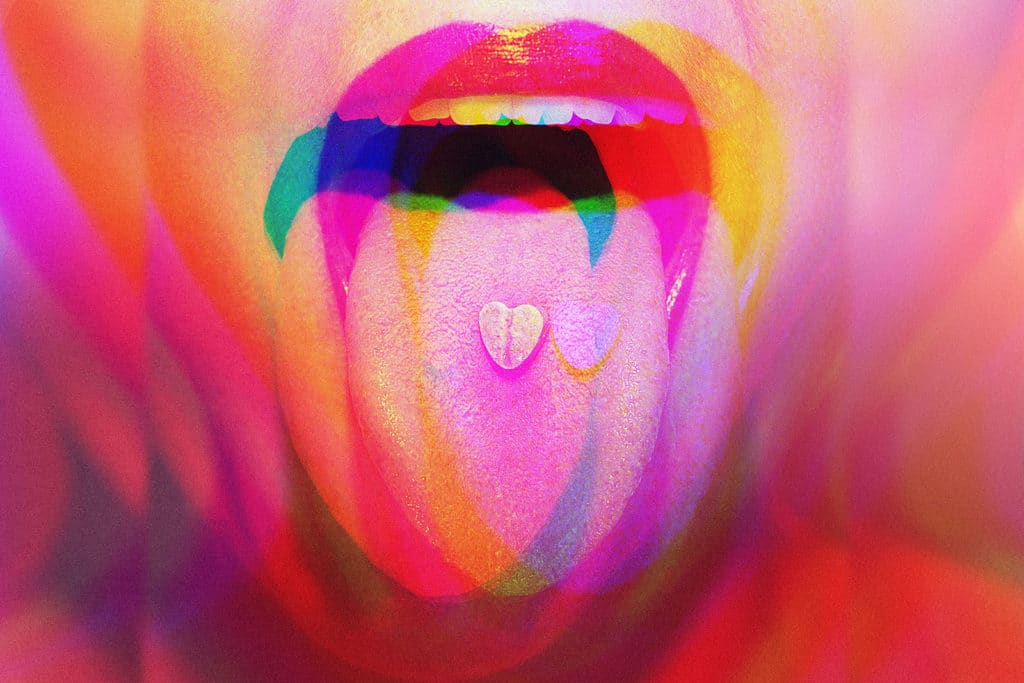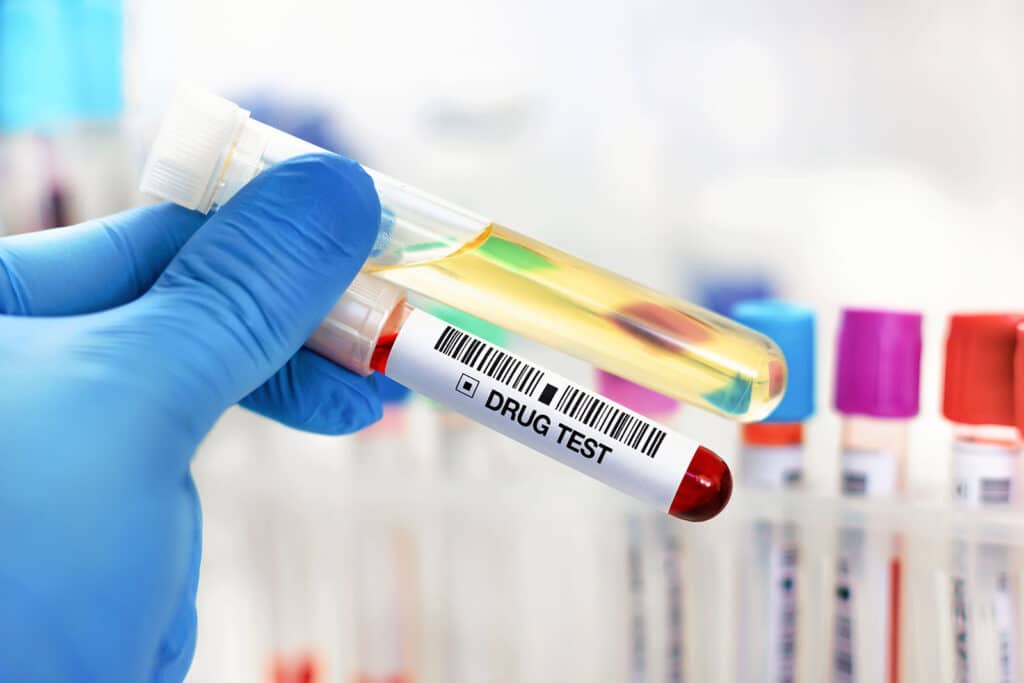MDMA, also known as Molly or Ecstasy, is a synthetic drug that causes effects similar to stimulants such as methamphetamine such as an increase in energy and well-being. Some researchers also consider it to be a psychedelic drug due to how it alters visual and time perception. It’s a popular drug in party and festival culture and is often sold as colorful tablets with imprinted logos that make them look somewhat like candy, although it can also be taken as a powder or a liquid. It first became popular in nightclubs, but people now like to take it in a variety of settings. Some researchers have even explored the possibility of using MDMA as a treatment for depression and post-traumatic stress disorder (PTSD) in clinical research trials.
MDMA works by influencing the activity of serotonin, dopamine, and norepinephrine in the brain. These are all neurotransmitters that influence mood and behavior. Increasing these neurotransmitters increases energy, and produces feelings of euphoria, warmth and openness toward others, and an increased sensitivity to sights, sounds, touch, and smells. The effects of MDMA usually begin within 45 minutes of taking a single dose. They peak within 15 to 30 minutes and usually last about three hours. After that, there is usually a comedown as the body adjusts to no longer having the drug in its system. This comedown can be difficult or even dangerous, and it’s important to understand how it can affect your health.

Table of Contents
- What Happens When You Come Down from MDMA?
- How MDMA Comedown Affects Physical and Mental Health
- How Long Does MDMA Last?
- Coping Strategies for MDMA Comedown
- Side Effects of MDMA
- Detection Times for Molly (MDMA) in Drug Tests
- When to Seek Help for MDMA Use
- Treatment Options at Illinois Recovery Center
What Happens When You Come Down from MDMA?
MDMA works primarily by increasing the levels of serotonin and other neurotransmitters in your brain. This increase in neurotransmitters make you feel happier and more energetic. Once the effects of MDMA wear off, you might experience a crash that can make you feel tired, sad, and irritable as your brain adjusts to the sudden change in neurotransmitter levels. The symptoms of an MDMA comedown include:
- Fatigue
- Depression
- Anxiety
- Irritability
- Difficulty concentrating
- Loss of appetite
- Difficulty sleeping
- Confusion
- Difficulty remembering things
- Headache
- Muscle soreness
- Dehydration from electrolyte imbalance
The length of an MDMA comedown varies from person to person and generally lasts between one and three days. The first day is usually the hardest as that is when the symptoms are at their most intense. The symptoms usually lessen after a day, although you may still feel their effects and feel tired or irritable for the next couple of days.
How MDMA Comedown Affects Physical and Mental Health
Coming down from MDMA has often been compared to a hangover from a night of heavy drinking. Many of the symptoms are similar, and you usually feel physically ill overall. However, an MDMA comedown is arguably more dangerous than a hangover caused by alcohol consumption. First of all, an MDMA comedown can make you feel depressed and generally dissatisfied with life. At its worst, these feelings of depression can cause psychosis or thoughts of suicide. It can also increase your craving for more MDMA and other substances. It isn’t clear whether MDMA is physically addictive, it does affect neurotransmitters in ways that are similar to other addictive substances. At the very least, MDMA is habit-forming, and repeated usage can be dangerous. High doses of MDMA can affect the body’s ability to regulate temperature. In rare instances, the temperature spike caused by a high dose of MDMA can lead to kidney failure, heart failure, and death.

A more common condition caused by repeated MDMA use is serotonin syndrome. This is caused by an abnormal increase of serotonin in the brain, which can cause symptoms such as:
- Increased body temperature
- Sweating
- Flushed skin
- High blood pressure
- A rapid pulse
- Rapid breathing
- Headaches
- Nausea
- Vomiting
- Diarrhea
- Confusion and disorientation
- Seizures
- Kidney damage
Long-term MDMA use might also cause long-lasting cognitive issues, although there is conflicting evidence that this is the case. Some researchers have said that those who have repeatedly used MDMA have shown memory and abstract reasoning deficits, while others have said that executive functioning remains largely intact.
How Long Does MDMA Last?
The duration of MDMA effects depends on several factors, including dosage, metabolism, body composition, and whether it’s taken with other substances. On average, MDMA effects last 3 to 6 hours, but the comedown and after-effects can persist for days.
MDMA Timeline: How Long It Lasts
| Stage | Timeframe | What Happens? |
|---|---|---|
| Onset | 30-60 minutes | Initial effects begin, feelings of energy and euphoria appear. |
| Peak Effects | 1.5 – 3 hours | Maximum intensity: increased empathy, sensory enhancement, and emotional openness. |
| Come Down | 3 – 6 hours | Effects start wearing off, fatigue and mood changes begin. |
| After-Effects (Comedown) | 1 – 3 days | Fatigue, depression, anxiety, irritability, sleep disturbances (“Tuesday Blues”). |
Factors That Influence MDMA Duration
- Dosage – Higher doses last longer but increase side effects.
- Purity – Adulterated MDMA (often mixed with stimulants) can last longer and cause unpredictable effects.
- Metabolism – Faster metabolism = shorter duration.
- Hydration Levels – Dehydration can intensify the effects, while overhydration can be dangerous.
- Other Substances – Mixing with alcohol, stimulants, or antidepressants can extend or shorten the high.
While the main MDMA high lasts 3-6 hours, the after-effects can linger for days. Since purity, dosage, and personal metabolism all impact duration, it’s important to understand how MDMA affects the body and brain over time.

Coping Strategies for MDMA Comedown
MDMA comedown and withdrawal are similar experiences, so much so that it can be hard to differentiate between the two. The biggest difference is that MDMA withdrawal happens after long-term use, while a comedown can happen after taking a single dose. If you are coming down from MDMA, it’s important that you rest, stay hydrated, and try to eat something. Putting any nutrients and calories into your body is a good thing when coming down from MDMA, but try to eat antioxidant-rich foods such as fruits, vegetables, nuts, and whole grains. You might feel nauseous and might even vomit from your comedown, but try to get something in your stomach. Spend at least the first day resting and trying to relax. Practice meditation and relaxation techniques, and try to distract yourself from any sadness or depression that you might be feeling. Most importantly, resist the urge to use more MDMA or any other substances to ease your symptoms. Using MDMA to stop the symptoms of a comedown can become a bad habit that can lead to dependency.
How Long Do the After-Effects Last?
After the high wears off, some users experience a crash or “comedown”, which can last 1-3 days.
Common after-effects include:
- Fatigue & low energy
- Depression & mood swings
- Irritability & anxiety
- Insomnia & brain fog
Heavy or frequent use can lead to longer-lasting serotonin depletion, making recovery take several weeks.
Side Effects of MDMA
MDMA (3,4-methylenedioxymethamphetamine), commonly known as Molly or Ecstasy, affects the brain and body in various ways. While some users seek its euphoric and social-enhancing effects, MDMA also comes with serious short-term and long-term risks.
Short-Term Side Effects (During & Shortly After Use)
These effects typically occur within 30 to 45 minutes after ingestion and can last 3 to 6 hours:
Physical Side Effects
- Increased heart rate & blood pressure
- Sweating & dehydration
- Jaw clenching & teeth grinding (bruxism)
- Nausea & loss of appetite
- Dilated pupils & blurred vision
- Muscle tension & cramps
- Elevated body temperature (risk of heat stroke)
Psychological Side Effects
- Euphoria & increased empathy
- Heightened sense of energy & stimulation
- Distorted perception of time
- Increased sociability & emotional openness
- Enhanced sensory perception (music, touch, lights)

Severe Risks
- Hyperthermia (Overheating) – Can lead to heat stroke, dehydration, or organ failure (common in clubs or raves).
- Serotonin Syndrome – Too much serotonin can cause agitation, confusion, high fever, rapid heartbeat, and seizures (especially when combined with SSRIs or other drugs).
- Hyponatremia (Low Sodium Levels) – Drinking excessive water while on MDMA can dilute sodium levels, leading to brain swelling.
Comedown Effects (“Tuesday Blues”)
After MDMA wears off, users may experience a crash for 1 to 3 days due to serotonin depletion. Symptoms may include:
- Fatigue & low energy
- Depression & anxiety
- Irritability & mood swings
- Insomnia or disturbed sleep
- Difficulty concentrating (“brain fog”)
Long-Term Side Effects (With Repeated Use)
Regular or heavy use of MDMA can lead to:
Physical Health Risks
- Heart problems – Increased risk of high blood pressure, heart disease, or arrhythmias
- Liver & kidney damage – Prolonged MDMA use can lead to organ damage due to overheating and toxicity
- Weakened immune system – Frequent use may compromise immune response
Mental & Cognitive Effects
- Depression & Anxiety – Chronic MDMA use can deplete serotonin, increasing the risk of mental health disorders
- Memory loss & cognitive issues – Long-term use may impair learning, memory, and decision-making
- Sleep disturbances – Irregular sleep patterns and insomnia

Addiction & Dependence Risks
While MDMA is not as physically addictive as opioids or stimulants, users can develop psychological dependence, leading to:
- Increased tolerance (needing higher doses for the same effect)
- Compulsive binge use
- Loss of interest in other activities
Dangerous Drug Interactions
Combining MDMA with other substances can increase risks:
- Alcohol – Dehydrates the body further & strains the liver
- Cocaine or Amphetamines – Overloads the cardiovascular system, increasing heart attack risk
- Antidepressants (SSRIs, MAOIs) – Can cause Serotonin Syndrome
- Psychedelics (LSD, Mushrooms, Ketamine) – May intensify hallucinations & anxiety
Harm Reduction Tips (If Someone Uses MDMA)
- Test the drug with reagent kits (to detect dangerous adulterants like fentanyl or PMA)
- Stay hydrated, but don’t overdrink (500ml per hour is enough)
- Take breaks if in a hot environment to avoid overheating
- Avoid mixing substances
- Wait several weeks before taking MDMA again to allow serotonin levels to recover
MDMA alters brain chemistry, heart function, and body temperature, making it risky—especially with frequent use or unsafe conditions. While some people may experience short-lived positive effects, the negative physical, mental, and long-term risks outweigh the highs.

Detection Times for Molly (MDMA) in Drug Tests
The detection window for MDMA (Molly) varies depending on the type of drug test used, individual metabolism, and other factors such as hydration levels, frequency of use, and overall health. Below are the approximate detection times for each test type:
| Test Type | Detection Window |
| Urine Test | 1-3 days (up to 5 days for heavy users) |
| Blood Test | 12-24 hours |
| Saliva Test | 1-2 days |
| Hair Follicle Test | Up to 90 days |
Factors That Influence Detection Time
- Dosage: Higher doses take longer to eliminate.
- Frequency of Use: Chronic users may test positive for longer.
- Metabolism: Faster metabolisms clear drugs more quickly.
- Hydration Levels: Drinking water can slightly help with elimination but won’t significantly speed up detox.
- Liver & Kidney Function: Impaired function may prolong drug detection.
How to Clear MDMA from Your System?
- Stay hydrated (but avoid excessive water intake, which can cause hyponatremia).
- Exercise & maintain a healthy metabolism to help eliminate waste products.
- Get plenty of sleep, as the body detoxes efficiently while resting.
- Time is the only true way to clear MDMA—no detox method will instantly remove it.
When to Seek Help for MDMA Use
Many MDMA users take the drug recreationally at special events and don’t think they have a problem. There is even debate over whether or not MDMA is physically addictive. And yet, it is possible to become dependent on MDMA, especially if you regularly use it to manage comedown and withdrawal symptoms. Signs that you should seek help for MDMA dependency include:
- Withdrawing from your friends and avoiding social events due to your MDMA use
- An inability to cut down on or stop MDMA use
- Taking more MDMA than intended, usually by taking back-to-back doses
- Continuing MDMA use despite the negative effects on your life
- Devoting much of your time and money to obtaining and taking MDMA

Treatment Options at Illinois Recovery Center
If you believe that you or a loved one has a problem with MDMA dependency, there is help available. Illinois Recovery Center provides addiction treatment programs, including inpatient and outpatient treatment, that are tailored to MDMA dependency and addiction. These usually begin with medical detox, during which you are placed in a setting where you can manage withdrawal and comedown symptoms safely. A medical staff will be on hand to manage the worst of your symptoms. After that, your ongoing treatment will depend on your unique situation. Our treatment options include:
- Behavioral therapy to address the underlying cause of your MDMA abuse
- Group therapy to provide support from peers
- Holistic approaches such as nutrition counseling and mindfulness-based therapy
- Dual-diagnosis treatment to address co-occurring disorders such as depression and anxiety
While many people think occasional MDMA use at parties and festivals is relatively safe, it can be dangerous. The comedown can hit hard, and prolonged use has been linked to memory issues and cognitive impairment. An addiction recovery program can help you develop a recovery plan if you believe that your MDMA use has become a problem. To learn more about the recovery programs offered by Illinois Recovery Center, contact us today. Our staff is available at all times to assist you and help you find the best recovery program for you.
Sources:
- https://nida.nih.gov/research-topics/mdma-ecstasy-molly#safe
- https://www.mayoclinic.org/diseases-conditions/serotonin-syndrome/symptoms-causes/syc-20354758



